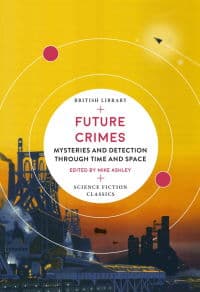
Future Crimes: Mysteries and Detection Through Time and Space edited by Mike Ashley
(British Library, 2021)
Reviewed by L. J. Hurst
Future Crimes is editor Mike Ashley’s tenth collection in the Science Fiction Classics series, following others on Mars, space monsters and catastrophes. Half of the authors here were American, and the rest British, though the British had mostly to find American outlets for their work.
The volume is subtitled “Mysteries and Detection through Time and Space”, with the paradoxes of time-travel opening and closing the volume. It begins with Anthony Boucher’s “Elsewhen” (1943) and closes with Miriam Allen deFord’s “The Absolutely Perfect Murder” (1965). Both owe a lot to other genres, particularly stories of suspense. We know that a murder is going to take place, even though the probable murderer seems a crackpot with his claim to have invented a time machine, and his consequent obvious attempts at manipulating an alibi based on a known time. Boucher and deFord’s professionalism, of course, comes from their ability to let the biter be bit in very different ways.
The stories by the three best-known authors come from a later period than most of the others: Isaac Asimov’s “Mirror Image” (1972), P.D. James’ “Murder, 1986” (1970), and Anne McCaffrey’s “Apple” (1969). “Mirror Image” is a late robot story (Asimov’s second robot detective novel The Naked Sun had appeared as long before as 1956), which revolves around academic jealousy, and does not require a robot for its solution at all. It does, though, tie in with Asimov’s only straight detective novel, A Whiff of Death (1958), which gives a grim portrait of American universities of the time.
“Puzzle for Spacemen” (1955) by John Brunner, “Death of a Telepath” (1959) by George Chailey, and “Nonentity” (1955) by E.C. Tubb all feature deaths in the depths of space which have to be investigated as potential murder, and then in identifying a potential murderer. Though two were published before and the third after the launch of Sputnik one can feel the greyness of the ‘50s even while the authors imagined spacecraft crossing—or marooned in—vast interstellar distances. There is no sense of the optimism of the alleged new Elizabethan era in these stories. Ted Tubb’s “Nonentity” shares some themes with the classic “Cold Equations” by Tom Godwin, while Mike Ashley compares “Death of a Telepath” to Alfred Bester’s The Demolished Man. Oddly, the solution of John Brunner’s puzzle could be found in a pre-WW1 Dr Thorndyke detective story (both depend on analysing the constituents of dust particles). Reference to pre-war brings us to Jacques Futrelle’s “The Flying Eye”, first published in 1912, months after he had died on the Titanic. Futrelle is best known for his Professor SFX “Thinking Machine” Van Dusen stories, which are frequently reprinted in Rivals of Sherlock Holmes volumes, but Mike Ashley has discovered one of a new series begun by Futrelle, featuring Paul Darraq, who investigates physical anomalies. The story—which begins with an apparently near-invisible sky octopus dragging people into the ether—is resolved with a technical explanation of aerial invisibility (which the USAAF is likely still working on, though Futrelle credits his hosts at the British Admiralty) combined with an equally likely degree of military incompetence. Eric Frank Russell’s “Legwork” (1956) reworks Dragnet and other police procedurals of the period to hunt for an alien visitor casing the Earth for future exploitation.
Mike Ashley recommends The Measure of Malice, a Crime Classic anthology as a partner to this volume, as it contains “scientific detective stories which have not dated”. There is always going to be an overlap between the development of science, as in these stories, and the development of logic which occurred in detective stories: I think he is right. With an interesting Introduction, and author details, and bibliography, Future Crimes shows that editor Ashley has done his legwork.
Review from BSFA Review 15 - Download your copy here.
